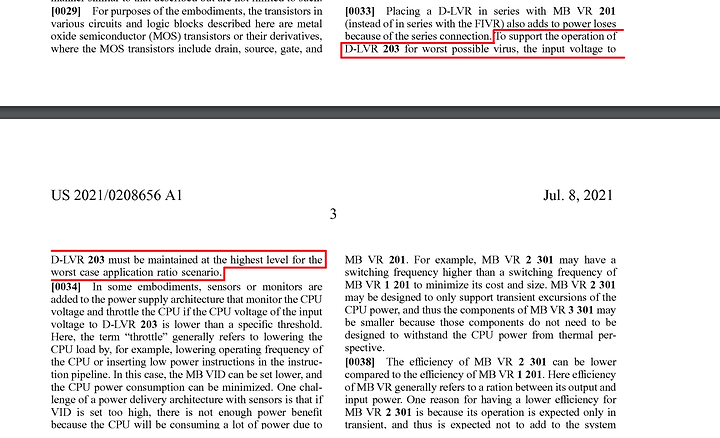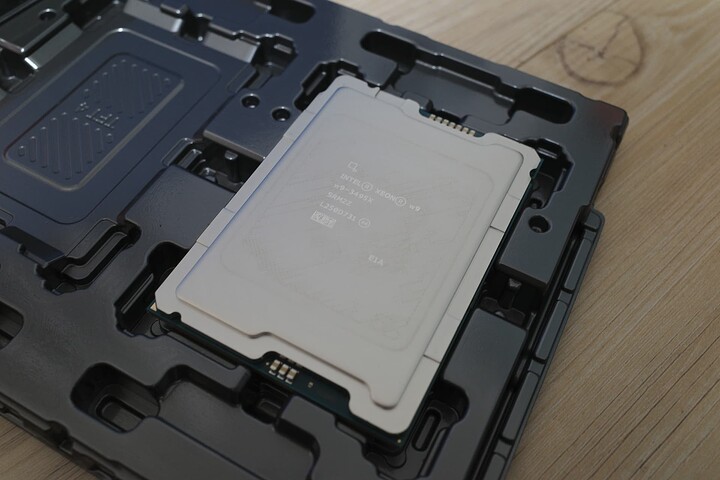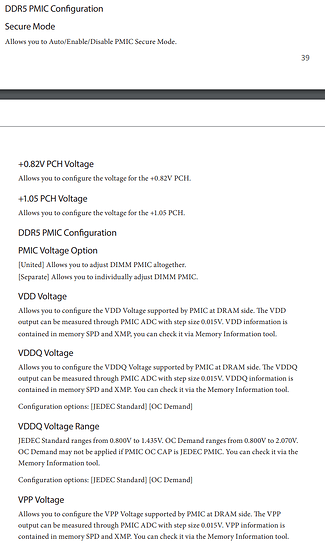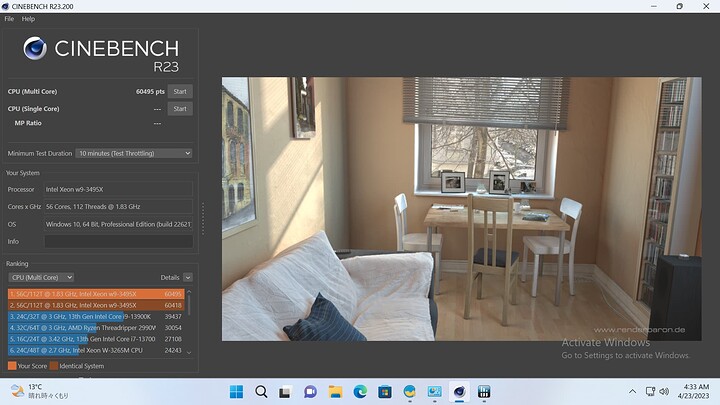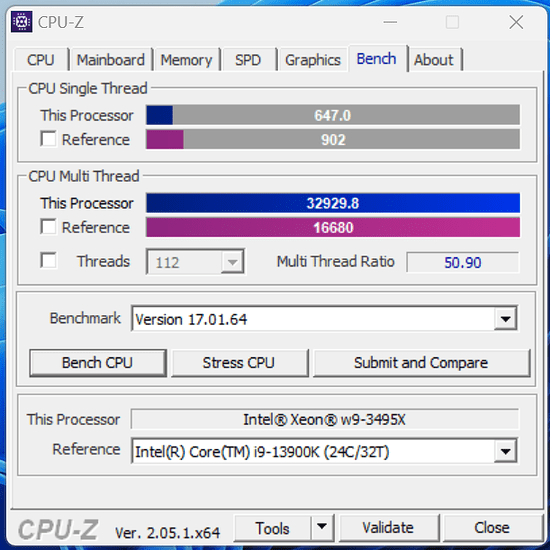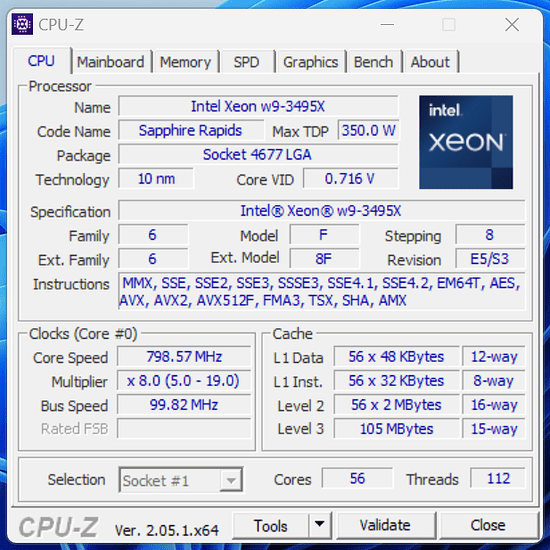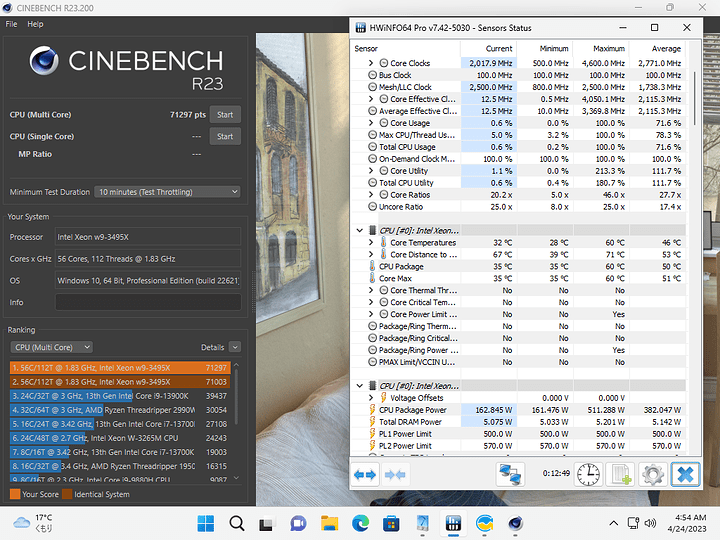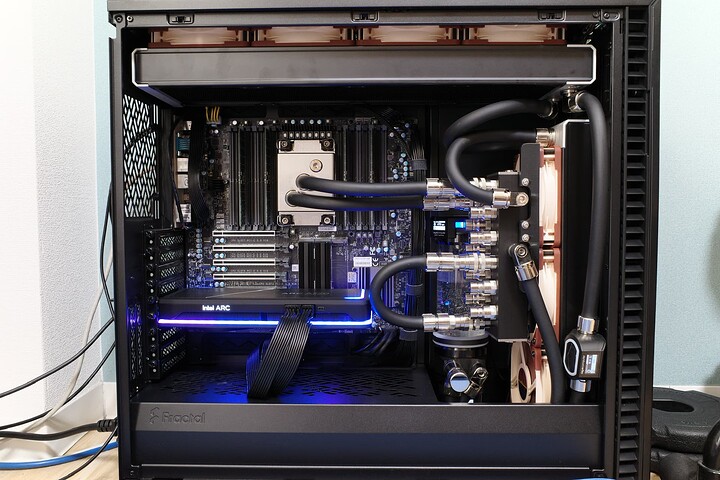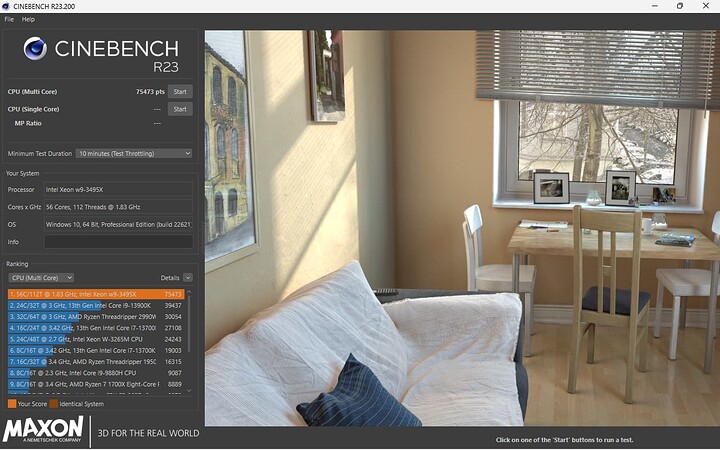G.SKILL finally put up details for their Zeta R5 kit on their website. Sadly, still no M/B QVL. The RAM seems slightly shorter than their UDIMM counterpart also (Zeta R5 - 31.2 mm / Ripjaws S5 - 33 mm).
has Intel something said about how long they wanna support this platform?
I guess we will get at least a raptor lake based refresh with working DLVR, right?
avadirect now has all the Kingston kits listed aswell… tops out at 1550USD for the 5600MT/s 256GB kit.
Team group is supposed to be launching a 6400MT/s 256GB kit for the platform.
I got the impression we’d at least get an emerald rapids refresh but that nothing was very likely after that. With Asus accidentally letting slip that zen 4 threadripper is coming around September, I think the chances of this platform being supported more long term have gotten greater.
DLVR is just FIVR, isn’t it? if so then we already have it in the sapphire rapids parts.
I don’t think so, FIVR was already a thing at 22nm and Intel filed the patent for Digital Linear Voltage Regulators in 2020.
Emerald Rapids is based on Raptor Cove, which is basically Raptor Lake for Socket 4677.
I just read the patent and felt my IQ drop by atleast 20 points.
This part gave me a chuckle:
Based off of the patent it sounds like DLVR is similar FIVR, but instead of being a secondary VR stage serially inbetween the motherboard and the processor, the motherboard will have two VRM channels, one will feed the CPU directly and one will feed DLVR which then feeds the CPU. Apparently this DLVR topology is more efficient since it generates less losses because not all the power is going through the CPU based-VRM and heating everything up.
This also explains why “FIVRA” options are in the BIOS of these SPR-WS boards; its talking about VRM channel A that feeds DLVR, while VRM channel B is doing its own thing.
It looks like the DDR5-6400 G.SKILL Zeta R5 Kit is now listed on some online retailer, but seems like only the 4x16 GB Kit (F5-6400R3239G16GQ4-ZR5K) is available (I guess because 8-channels Xeon-w 3400 is releasing in late April). The kit currently floats around 600-700 USD.
One of the retailers in Japan actually sold the kit for $630, which is surprising considering everything is normally 1.3x more expensive here. I guess MSRP is probably closer to $500.
Thanks for the heads up!
I’m kind of surprised at the XMP RDIMM prices in general; I would have thought for sure they would carry super high premiums (>200%) over RDIMMs and “overclocker” memory but that doesn’t seem to be the case
I’ve been trying to collect the parts for a w790 build before they get sold out.
The LGA4677 EK water blocks are actually out on 3rd party sites even though EKWB doesn’t list it as being available on their own site yet.
I’m also quite surprised how reasonable these kit turned out to be. I was expecting at least 50% premium over JEDEC, but it turned out to be around 20-30%.
I’ve been trying to collect the parts for a w790 build before they get sold out.
The LGA4677 EK water blocks are actually out on 3rd party sites even though EKWB doesn’t list it as being available on their own site yet.
I thought of going with Alphacool’s ES Jet LGA4677 at first, but it keeps getting delayed (was end of April, then beginning of June, now end of June). I ended up snatching one of the EK’s block late last month when I saw it was available at a local retailer.
Though, I also got the Noctua-U14S DX-4677 just in case I couldn’t get all the watercooling parts before the CPU, although it’s confirmed by Noctua to overhang the top PCI-e slot on the X13SWA-TF board. On the other hand, according to @aschilling it looks like Noctua coolers for LGA4677 allow the CPU to pull 500+ W at varying noise level (thanks to the larger die area).
I got my hands on the CPU. 3435X, 3465X, and 3475X are now available as boxed, but 3495X is tray-only.
Sadly, G.SKILL still doesn’t seem to have a 256 GB kit available for purchase, so I’ve got DDR5-4800 RDIMM 64 GB x 4 for now. Looking at Hardwareluxx.de’s benchmark, the Xeon seems to scale pretty well with memory speed, so I hope to get at least DDR5-5600…
I haven’t got this thing running yet, I ran out of coolant for my watercooling loop…
Nice.
I’m on the look out for a 3435X now, still don’t see any stores selling them in the states yet.
I’m going to try to hold out for the G.Skill 256GB DDR5-6400 kit, F5-6400R3239G32GE8-ZR5K, which isn’t even listed on their website yet… we’ll see how impatient I get
I’ve got the machine to boot & everything working. Turns out, Supermicro board does support memory overclock beyond 5600 MHz, but I can’t find anywhere to adjust memory voltage (or does voltage work differently for RDIMM? Given it has an on-DIMM voltage regulator?)
From what I gathered, is that the stock is extremely limited. Here in Japan, there are 3 retailers listing them for sale, and each of them seems to only have a single unit of each 3435X, 3465X, 3475X, and 3495X.
(p.s. look at all my cores!)
Done any benchmarks yet? I’m curious about cpu-z single core benchmark and I haven’t seen anyone post one online yet.
The Asrock W790 board has memory voltage settings in it’s BIOS:
alittle more complicated than how I remember DRAM voltages settings being.
I’ve done some quick benchmark runs. Everything running under the default PL1=350W, PL2=420W, and with Octa DDR5-4800.
Cinebench R23
(Yes, I haven’t activated Windows. I’m just using it to set up my loop hardware and a few benchmark runs, please don’t judge
CPU-Z:
Stepping information:
(“E5/S3”? The sample Derbauer got on his video was “E5”, and ES that overclockers got their hands on was “E3”. Is this the case of v5_Final_Finalv2_REALLYFINAL?)
Some initial findings:
- The w9-3495X is clocked so low that Windows’ default “Balance” power profile makes the entire system unresponsive. Every interaction took 2+ seconds, e.g., to open Windows Explorer. HWiNFO reported a very low number of 180 MHz for “Core Clocks” with Uncore VID of 0.690V.
- Setting it to “High Performance” makes “Core Clocks” runs at 400-500 MHz range. The system is much more responsive at the expense of higher power consumption (80W vs. 150W). I think anything below w7-3465X may do much better in this regard.
- CPU-Z and HWiNFO report quite a different number for clock speed at low power states. I’m not sure whom to trust here.
- A simple bumping PL1/PL2 to 800W boost the multicore performance by about 10% (CB R23 score went up to 65000-66000 range), but I found that stock clock settings for w9-3495X never exceed 500W while running Cinebench R23. Some tuning is probably required here.
- Since the die area is so huge, and I’m running a custom loop (360+480 radiators) my CPU never exceeds 50c even after 2 hours of y-cruncher run. Air cooling could have been a practical option.
Generally, I’m happy with the platform, but I think w9-3495X really requires overclocking. Intel seems to clock the CPU far too low to meet the power budget, and it would be interesting if Intel were to release Emerald Rapids-WS with DIVR. Please let me know if you want me to run any other benchmarks.
Ah, thanks for this. Memory overclocking on Supermicro is really a no-go, then. I can’t seem to find any way to adjust memory timings either. (There’s an option to play around with RAS, but not RAS timings).
hmmm… I would have expected the single core cpu-z score to be higher, maybe around ~760 points at max clocks. Did you happen to observe what clock speed the cpu was running at while the single core portion of the test was happening?
I’m suspicious that Windows is mishandling clock ramping and maybe even core scheduling on such a new architecture.
oh there is one benchmark I’d like to see if it isn’t too much trouble. It’s located in this thread:
Its a benchmark for a FEA problem I was solving that stresses memory particularly hard; It does require a comsol runtime installation (part of that big executable in the drive) though which is kind of a pain.
Looking to get one of these to upgrade from my Xeon 8280 machine, so thanks for the benchmarks!
if you dont mind, would you share some Build Pics always nice to see some pretty pics;)
Some quick overclocking; bumping All Cores Turbo Ratio to x36 (from x29) and setting PL1=500W, PL2=570W.
And 2 Cores Turbo Ratio at x50 (from x48):
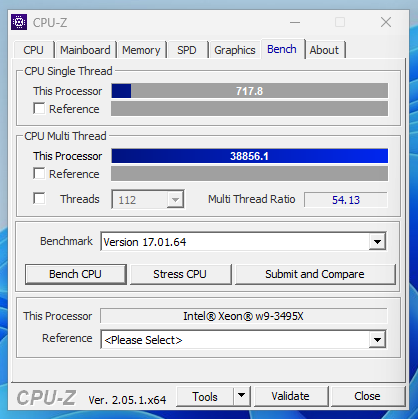
(Though, I don’t think it reaches max clock during this run)
The VRM on the Supermicro’s X13SWA-TF shoots to 100 °C and throttles immediately once it reaches 500W. But this is with very little airflow, adding some fans will probably help.
In that test, I believe it was running at around 4 GHz. I think the clock ramp-up behavior is very slow for some reason. In Cinebench I saw the score went up the longer I run in the multicore benchmark. Running CPU-Z benchmark in succession bumped the score up to around ~680, but it couldn’t go any higher due to the length of the test.
I think this may be a bug in Windows rather than a problem with SPR; on Linux the system stays very responsive in the lowest power state (consuming ~60W idle vs ~150W on Windows with “Performance” profile).
I couldn’t successfully run this on both Windows 11 and Linux; on Windows it crashes immediately after the splash screen (COMSOL installation was successful), and on Linux (both Ubuntu 23.04 and KDE Neon) it crashes after compute to about 40%. Is there anything I should try?
Sure ![]()
The build is still WIP, I’m still missing a GPU (or maybe GPUs) which is why there’s a tube looping from a Manifold distribution block into itself; otherwise it won’t work, 4 more RAMs, redesign the Manifold mount so there’s some more gap between the fan and the Manifold, etc., but I’m happy with how it turned out.
I agree
TBH I’ve never run into that before. Ignoring the Windows results, the only thing I can think of that would cause a crash is a system memory error which I would assume wouldn’t happen with ECC memory; did the IPMI log any memory errors around the time it was run?
Edit: Another thing that would be able to cause a crash is the system running out of memory during the run, it’ll silently crash if this happens.
Newegg now has the W-3400 SPR-WS cpus for sale, just unlisted. I should have mine in 2 days.
I’ve heard from a Japanese reviewer that ASRock’s latest BIOS for W790 WS (3.04 released 2023/04/21) has fixed the responsiveness issue when running “Balanced” performance profile on Windows (although they were running 2495X). Still nothing from Supermicro or ASUS, however.
On the other hand, it looks like VRM on Supermicro board throttles at around 500W. I tried putting the fan on the VRM and gained 4,000 extra points from previous run (All Cores 3.4 GHz):
I think the Supermicro board may be more suitable for air cooling, since it looks to rely on some air going through the heatsink fins to cool the VRM (direct airflow is blocked by RAM).
TBH I’ve never run into that before. Ignoring the Windows results, the only thing I can think of that would cause a crash is a system memory error which I would assume wouldn’t happen with ECC memory; did the IPMI log any memory errors around the time it was run?
Since I see it tries to create OpenGL context, maybe it has something to do with Intel ARC driver on both Linux and Windows. I didn’t see any memory-related errors on both Windows and Linux side (though I didn’t dig too far). On Linux running out of memory could may be the reason; I only have 256GB installed right now with no swap.
Newegg now has the W-3400 SPR-WS cpus for sale, just unlisted. I should have mine in 2 days.
Congrats on getting the order through!
I’ve got the W790 SAGE w/ a 3475X and 128GB of G.Skill 6400 Zeta goodness. Works like a charm, immediately booted with XMP on, and haven’t had any faults yet. Once I can get a bit further along with some other parts, I can toss the other three 4090s in the rig w/ their respective waterblocks.
Currently using the EK Pro 4677 block and not a single lick of trouble from it. Using the third port to monitor liquid temps
I’ve got the same block and board, I’m even doing the same with the temp sensor.
Once you have final setup, you should post pictures. I’ll be posting pictures of mine tomorrow when I get my last pump bracket, it’ll be my first water cooled build.
Out of curiosity, what torque wrenches/screwdrivers to mount the blocks are you guys using?
I saw that EK made a screw driver for mounting the blocks but ~20USD seems too cheap to be a proper torque driver.
HWiNFO reported a very low number of 180 MHz for “Core Clocks” with Uncore VID of 0.690V.
I watched the kitguru video on the w790 and they mentioned that the discrepancies in hwinfo reporting were due to Windows 11’s HVCI, Hypervisor-Enforced Code Integrity, being on by default, apparently turning it off will fix the hwinfo reporting issues and possibly improve performance.
Since I see it tries to create OpenGL context, maybe it has something to do with Intel ARC driver on both Linux and Windows. I didn’t see any memory-related errors on both Windows and Linux side (though I didn’t dig too far). On Linux running out of memory could may be the reason; I only have 256GB installed right now with no swap.
If you’re interested in troubleshooting if the Intel ARC driver is the cause, you can force the application to use a software renderer instead of an opengl renderer by using the argument -3drend sw during launch.
Now that I think about it, running out of RAM is definitely the problem for the failure during run; RAM usage and core count usage are related and I originally designed the benchmark to use 200GB of RAM for a 32 core machine, going up to 56 cores likely pushed the RAM usage over 256GB. An -np 32 argument during application launch would force the use of only 32 cores and be leaner on memory.
The only component I don’t have now is RAM. I really wanted to wait for 32GB Hynix A-die memory to come out but I am getting impatient. Kingston has 32GB Hynix M-Die RDIMMs they sell that’ll run at 5600MHz.
